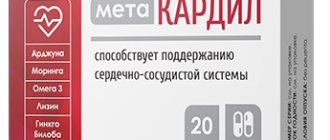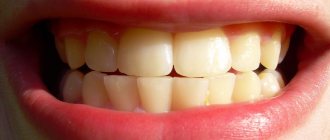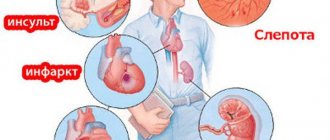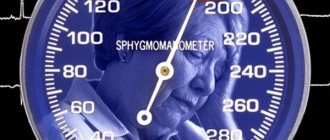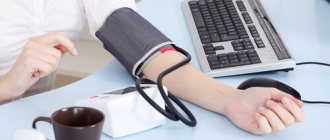The diary is an integral part of training for patients with arterial hypertension at the School of Health. These are your notes for memory - what you need to know, be able to do and do so that your blood pressure does not increase and your quality of life is good.
What needs to be controlled:
- Arterial pressure
- Body weight
- Waist
- Waist/hip index
- Total cholesterol
- Blood sugar
Blood pressure (BP) control
Regular blood pressure monitoring is not only blood pressure measurement, it is also a set of measures aimed at reducing the risk of complications. If an increase in pressure is detected, it is recommended:
- undergo examinations recommended by your doctor;
- determine the risk of complications; pay attention to risk factors;
- follow the rules below regarding nutrition, physical activity, etc.;
- regularly measure blood pressure: at least once a year - in case of a single unstable increase in blood pressure discovered by chance; at least once a month - if you feel well, but have a tendency to frequent or stable increases in blood pressure; at least 2 times a day - in case of exacerbation, stable increase in blood pressure and poor health.
If the pressure rises sharply and a crisis develops
- It is necessary not only to measure blood pressure, but also to write it down in a diary or on a piece of paper.
- Call an ambulance doctor.
- Take fast-acting drugs under the tongue: clonidine (clonidine) 0.075-0.15 mg, captopril (Capoten) 25-50 mg, nifedipine (Corinfar) 10 mg.
If chest pain occurs (manifestation of angina), take nitroglycerin under the tongue.
Do not use ineffective drugs - papazole, dibazole tablets.
Do not sharply reduce blood pressure over a short period of time.
Further actions will be determined by the ambulance doctor.
Example of a self-monitoring diary in Excel
If you have constant access to a computer, then filling out the diary can be slightly automated using Excel. For myself, I chose the first option of the self-monitoring diary, inserted a button into it to add readings, which opens a form with the date and time automatically filled in. If necessary, they can be edited both in the form itself and after recording on the worksheet.
Instructions for filling out a blood pressure self-monitoring diary in Excel:
- Click the “Add” button: a form will open with the date and time already filled in.
- Add the tonometer readings to the appropriate fields.
- “Well-being” and “Note” can be selected from the drop-down list*, filled in yourself, or left blank.
- Click the “OK” button and the data from the form will be written to a new row in the table, and the workbook will be saved.
* You can independently specify what data will be shown in the drop-down lists. To do this, simply edit the cell values in the “Wellness” and “Note” columns on the “LD and Appointments” worksheet. The cells of these columns must be filled from top to bottom without gaps.
In the “Note” column you can write:
- presence of arrhythmia;
- medications taken and their dosage;
- body weight, if it is monitored;
- doctor visits;
- other useful information.
It is convenient to move around the form while recording readings using the “Tab” or “Enter” keys. During the transition, the “Well-being” and “Note” fields are skipped, since they are not always filled out.
Doctor's orders and recommendations
Following your doctor's recommendations will help:
- get rid of the disease if the pressure rises slightly;
- achieve a reduction in blood pressure faster and reduce the dose of medications if there is a persistent increase in blood pressure.
Principles of rational nutrition
Balance of energy intake from food (energy intake) and energy expenditure per day.
Balance of nutrients.
Proteins, fats, carbohydrates, vitamins and minerals must be supplied in sufficient quantities and in certain proportions.
Diet.
It is advisable to eat at least 4-5 times a day, at the same time, without overeating before bed.
Limiting salt consumption Consume no more than 5 g of table salt per day (a level teaspoon), increase the consumption of foods rich in potassium salts to 5-6 g.
Which foods are not recommended?
Fatty meats, strong meat broths, beef, lamb, pork fat, butter, mayonnaise, internal organs of animals, brains, caviar, lard, cream, baked goods, cream cakes, spicy, salty, fatty snacks, cocoa, chocolate, butter ice cream, alcoholic drinks.
What foods are recommended?
Bread and bakery products: bran, with phosphatides, salt-free, fortified.
Soups: vegetarian, fruit, dairy. Meat and fish dishes: low-fat varieties. Fruits, berries, dessert: any, a lot.
Dishes and side dishes from cereals and pasta: porridge, puddings, casseroles.
Eggs: white steamed omelettes.
Dairy products: low-fat varieties.
Fats: vegetable oil in salads.
Drinks: weak tea, juices, kvass, rosehip infusion, herbs.
Snacks: unsalted cheeses, low-fat sausages, vinaigrettes and salads.
Sauces: milk, vegetable broth, fruit, berry.
ABPM VARIABILITY
Blood pressure is one of more than 300 physiological processes in the body that are subject to circadian rhythms. Registration of blood pressure, provided that pressure is measured at intervals of 15–30 minutes throughout the day, gives a fairly accurate idea of BP variability. To assess variability, the following are used:
1. Determination of the daily index.
2. Calculation of the standard deviation or coefficient of blood pressure variability.
The daily index (DI) shows the difference between the average daytime and nighttime blood pressure values as a percentage of the daily average value and is calculated by the formula:
SI = (Avg. ADdn. - Avg. BP night.) : Avg. BP days x 100%.
The average SI values obtained in our study during 24-hour blood pressure monitoring are presented in Table 5.
Table 5. Average daily index values in healthy adolescents (13–15 years old) based on ABPM results
| Options | Boys | Girls | ||||
| GARDEN | DBP | BP avg. | GARDEN | DBP | ADsr. | |
| SI (%) | 12,2 | 18,8 | 16,6 | 12,1 | 20,2 | 17,2 |
For most people, nighttime blood pressure decreases by 10–20% compared to daytime levels. Based on the daily index value, four groups of patients are distinguished:
“dippers” – SI 10 – 20%,
“non-dippers” – SI 0 – 10%,
“over-dippers” – SI > 20%,
“night-peakers” – SI < 0.
According to our data, in 85% of healthy children the SI for SBP and DBP exceeds 10% “dippers”. Normally, children “night-peakers” are not found, i.e. with nighttime blood pressure exceeding average daytime values.
The coefficient of variation (KB) is a calculated indicator and is determined by the formula:
kb = CO:Avg x 100
where KB is the coefficient of variation,
SD – standard deviation,
Av – average value of the parameter.
The KB values obtained in our study during 24-hour blood pressure monitoring are presented in Table 6.
Table 6. Standard values of the coefficient of variation in healthy adolescents
| Index | Day | Night | ||||
| GARDEN | DBP | HELL | GARDEN | DBP | HELL | |
| Girls | ||||||
| KB, % | 11.3 | 16,3 | 12,3 | 10,6 | 14,4 | 12,1 |
| Boys | ||||||
| KB, % | 11.2 | 14,5 | 12,1 | 11,2 | 14,7 | 12,7 |
In Fig. Figure 1 shows the daily profile of average hemodynamic blood pressure, constructed on the basis of a polynomial analysis of data obtained from daily blood pressure monitoring in adolescents of both sexes (6th degree polynomial). According to our data, healthy children have a minimum blood pressure of avg. at 2 am. Subsequently, blood pressure increases and reaches the first peak at 10–11 am, decreases moderately at 4 pm and the second peak is observed at 19–20 pm.
Rice. 1. Daily profile of mean hemodynamic blood pressure in healthy adolescents.
In modern conditions, early detection of changes in blood pressure levels in children is extremely important. Daily blood pressure monitoring allows you to verify initial deviations in the circadian rhythm and blood pressure. Currently, there are no normative ABPM data for children. This manual summarizes the first experience in conducting and analyzing ABPM in children. If ABPM parameters exceed the specified limits, it is not clearly pathological, but should be considered as a risk factor for the development of hypertension in adult life.
Like adults, children with arterial hypertension, as a rule, do not have any external manifestations and signs that clearly distinguish between essential and symptomatic hypertension. Further accumulation of experience in conducting 24-hour blood pressure monitoring in children with renal, endocrine pathologies, and essential hypertension will provide new criteria for the differential diagnosis of these diseases.
Bad habits, what to do
Smoking. Nicotine contained in cigarette smoke excites, increases the load on the heart, causes vasoconstriction, and increases blood pressure.
Alcohol. Under the influence of alcohol, control over your well-being is lost, and increased blood pressure becomes more dangerous. It is advisable to stop drinking alcohol. If this is difficult to do, you need to know that doses of alcohol of more than 30 g for men (this is a glass of vodka or cognac, a glass of wine, a can of beer) and more than 15 g for women per day, in terms of pure alcohol, are dangerous for arterial hypertension.
Notes and download links
You can download the self-control diary from the link below. The archive offered for downloading contains two files: a diary of self-monitoring of blood pressure and a file with forms of tables of option 1 and option 2 for printing.
The spreadsheets and diary were created in Excel 2021 and saved in Excel 1997-2003 format, so users of Excel 1997-2003 may need to adjust the page layout of the forms for correct printing.
While keeping a diary, I discovered that I never filled out the “Well-being” column. Therefore, in my version of the self-control diary, I replaced the “Well-being” column with the “Pills” column, in which I record the medications taken and their dosage. You can download a blood pressure diary with a “Pills” column from the link below.
The benefits of physical activity. Self-control
Before you begin any physical activity, consult your doctor. At the height of the load, the pulse should not exceed 110-130 beats per minute.
Exercises should not provoke shortness of breath, profuse sweating, general weakness, or heart pain. The appearance of these symptoms indicates inadequacy of the loads and is a signal to reduce the intensity of the load and re-consult a doctor.
Warning! If your well-being after exercise worsens significantly (sleep, appetite, performance are disturbed, discomfort appears), then this requires a reduction in loads and repeated consultation with a specialist.
Smartphone application
Now you can use specially created software for mobile devices as a diary for hypertensive patients.
The most popular is the special ICare application - the program can be used both as a diary and as an activity tracker, as well as a clear, step-by-step guide to some exercises. As diary entries, it makes sense to keep records, for example, of glucose and temperature, and in automatic mode, through the use of a camera, you can measure blood pressure, pulse, PWV and some other physiological constants. So, thanks to scientific and technological progress, monitoring key biometric indicators has become much easier and more accessible. But it would be very good to measure blood pressure some time immediately after taking the antihypertensive effect of drugs, especially since now there is an excellent opportunity to control, enter and monitor indicators online.
A table for measuring blood pressure is the most important element in the management tactics of any hypertensive patient, and a responsible attitude towards one’s health is the basis for stabilizing hypertension.
How to start moving more
Entering the physical activity regime should be done gradually - the less physically active you are, the slower you should increase the load.
You should try to maintain regularity of classes 3-5 times a week. The most realistic way to start with measured walking in a training mode is a fast pace without stopping (approximately 120 steps per minute).
You need to start gradually, increasing the pace and distance of walking, having determined the initial individual limit of walking at a normal pace until you stop (fatigue, shortness of breath, pain, etc.). How to estimate body weight To easily determine the presence of excess weight, it is recommended to use the formula for men “height - 100”, for women “height - 105” or tables for determining normal body weight. It is very important to maintain a balance between the energy we receive from food and the energy expenditure of the body.
Table of normal pressure by age
Table of normal blood pressure in a person depending on age (average values) according to the Zdrav-answer website:
| Age | Men | Women |
| 20 years | 123 by 76 | 116 by 72 |
| 30 years | 126 by 79 | 120 by 75 |
| 40 years | 129 by 81 | 127 by 80 |
| 50 years | 135 to 83 | 135 by 84 |
| 60-65 years | 135 by 85 | 135 by 85 |
| over 65 years old | 135 to 89 | 135 to 89 |
Where to start losing weight
Step 1 is to analyze the causes of excess body weight. Start keeping a food diary and continue for at least one week.
Step 2 is to assess the compliance of energy intake with recommendations for reducing calorie intake to reduce body weight. Draw your own conclusions and, if energy intake was high, evaluate which products could be excluded.
Step 3 - start taking action. To lose weight, you need to balance your caloric intake and increase physical activity. It makes the most sense to start normalizing your weight by reviewing your eating habits and composition, losing a few extra pounds, and to achieve a more stable normal weight, you can start exercising.
INDICATIONS AND CONTRAINDICATIONS FOR THE USE OF THE METHOD
The main indications for ABPM are:
1. Arterial hypertension.
2. Arterial hypotension.
3. Syncope.
4. Short-term, difficult to register during random measurements, fluctuations in blood pressure.
5. White coat hypertension.
6. Hypertension refractory to drug therapy.
There are no absolute contraindications to the use of the ABPM method in pediatrics. Possible complications include:
1. Swelling of the forearm and hand.
2. Petechial hemorrhages.
3. Contact dermatitis.
In order to prevent the occurrence of petechial hemorrhages, ABPM should not be administered to children with thrombocytopenia, thrombocytopathy and other disorders of vascular-platelet hemostasis during an exacerbation. To prevent the development of edema of the distal part of the limb and contact dermatitis, the cuff should be placed not on the bare shoulder, but on the sleeve of a thin shirt.
Stress
It is almost impossible to avoid many conflict situations, but you can learn to treat them correctly and neutralize them. The worst way to “discharge” is to take out your resentment and anger on loved ones, which causes double harm.
It is necessary to avoid overwork, especially chronic fatigue.
Alternate between mental and physical work.
The tips and rules outlined above can be supplemented by individual recommendations from the attending physician, which must be recorded in the diary.
Electronic pressure diary
Many modern blood pressure monitors are equipped with a synchronization function with a smartphone or computer via special applications and Bluetooth technology. This means that the measurement results are automatically sent to a program that organizes the data and stores it.
This option allows you to view the recorded information at any time in a convenient form or display it in the form of graphs and diagrams. You can print all this out and show it to your doctor. With such a pressure diary, it is impossible to forget about entering indicators: this happens automatically.
How to measure your blood pressure correctly
Blood pressure is measured twice a day, after waking up and before going to bed. If the condition worsens during the day, additional studies are carried out.
Basic measurement rules:
- You should not drink coffee, strong tea, or smoke for an hour before diagnosis.
- Before the procedure, you should calm down, take a comfortable sitting or lying position with support on your back. Do not cross your legs, do not move or talk. Free your hand from clothing and place it motionless on any surface.
- The cuff of the device must be of the appropriate size. When measured, it should cover the entire circumference of the arm and be at the level of the heart.
- You need to measure the pressure on both hands one by one. It’s better to do 2-3 times on each one, only after the cuff is completely free of air.
For home use, it is better to purchase an electronic tonometer.
It is easy to use and will provide more accurate numbers. The tonometer must be in good working order.
A person’s responsibility for their health is no less important than the responsibility of doctors. Keeping a diary for hypertensive patients should become a daily norm. This will significantly reduce the incidence of complications and reduce the risk of developing cardiovascular diseases.
THERE ARE CONTRAINDICATIONS CONSULTATION WITH YOUR DOCTOR IS REQUIRED
Author of the article Svetlana Anatolyevna Ivanova, general practitioner
Blood pressure control. Self-control diary. Measurement rules. Recording tonometer readings. blood pressure diary in Excel for filling out on the computer and table forms for printing and filling out manually.
Templates
The blood pressure diary is a table with the following columns:
- date of;
- time;
- blood pressure readings;
- heart rate;
- description of well-being.
Examples of table design are presented in two versions.
Option number 1. Diary template for working people
If a person, due to his busy schedule, measures his blood pressure only twice a day (morning and evening), the following table will suit him:
| Morning | Evening | Statement of well-being | |
| HELL | Pulse | HELL | Pulse |
| 01.01.20… | / | / | |
In this case, tonometry is performed at a certain time, for example, 20 minutes after waking up and before going to bed.
Who needs this?
Strictly speaking, every person who has crossed the forty-year mark should keep a diary for tracking their own blood pressure. And for people who have problems with blood pressure levels (hypertensives, hypotensives), this is necessary and mandatory. After all, its daily monitoring is an invaluable aid to the doctor in selecting specific therapy.
- Blood pressure measurement algorithm
Blood pressure is an extremely variable value. Under the influence of certain factors, it changes many times a day. It is impossible to assess a person’s condition from a single measurement at a doctor’s appointment. That is why experts recommend taking measurements at home yourself, then entering the data into a table.
By analyzing the daily fluctuations in the patient’s blood pressure level, the cardiologist will quickly establish a diagnosis and select the optimal dosage of medications.
Moreover, it has already been proven that a person’s involvement in the therapy process increases interest in recovery, and treatment brings better results.
How to keep a diary
Indicators must be accompanied by dates and hour markers. Be sure to indicate the time of day and heart rate. It is important to follow the regime not only during measurements, but also during treatment.
In addition to the numbers in the diary of a hypertensive patient, you need to record events accompanying the increase in blood pressure.
Describe the physical manifestations of the disease, routine moments and medications taken. Additionally, measurements of blood sugar and cholesterol levels, weight and body volume may be required.
A reminder in the form of training for hypertensive patients will help with the issue of self-control:
- I understand the need to follow doctor’s orders, take medications on time and measure blood pressure. I promise to eat right, be physically active, and quit smoking and alcohol. I know what to do in case of an exacerbation of the disease.
- I am aware of the unsafety of self-medication and imagine possible harm if I neglect this rule.
- I strive for a healthy lifestyle, maintaining physical and moral strength. I maintain interest in life, positivity, communicate with friends, experience mutual feelings.
- I control my emotions and avoid stress.
- It is in my interests to follow all instructions in order to speed up healing and avoid deterioration.
Recommendations for keeping a diary
You can print out a diary form or draw out a table in a regular squared notebook and write down the readings manually. The main thing is not to forget to fill it out every day. To do this, you can set a reminder on your phone or write a note and attach it in a visible place.
For smartphone owners, there are special applications that will make it easier to keep a blood pressure diary. Just download the program to your phone, and the diary will always be at hand. Based on the readings, blood pressure graphs are generated that will clearly demonstrate how it changed during the period, what the maximum, minimum and average values were. All data can be exported to an Excel spreadsheet and printed or emailed to the doctor.
Keeping a blood pressure diary is not difficult, but it will help avoid complications of hypertension and improve the quality and length of life.
Do you still think that it is impossible to cure hypertension?
Hypertension, unfortunately, always leads to heart attack or stroke and death. For many years, we only stopped the symptoms of the disease, namely high blood pressure.
Only constant use of antihypertensive drugs could allow a person to live.
Now hypertension can be CURED; this is available to every resident of the Russian Federation.
Was the article helpful?
Rate the material on a five-point scale!
If you have any questions or want to share your opinion or experience, write a comment below.
Diary of patients with arterial hypertension
The diary is an integral part of training for patients with arterial hypertension at the School of Health. These are your notes for memory - what you need to know, be able to do and do so that your blood pressure does not increase and your quality of life is good.
What needs to be controlled
- Arterial pressure
- Body weight
- Waist
- Waist/hip index
- Total cholesterol
- Blood sugar
Blood pressure (BP) control
Regular blood pressure monitoring is not only blood pressure measurement, it is also a set of measures aimed at reducing the risk of complications. If an increase in pressure is detected, it is recommended:
- undergo examinations recommended by your doctor;
- determine the risk of complications; pay attention to risk factors;
- follow the rules below regarding nutrition, physical activity, etc.;
- regularly measure blood pressure: at least once a year - in case of a single unstable increase in blood pressure discovered by chance; at least once a month - if you feel well, but have a tendency to frequent or stable increases in blood pressure; at least 2 times a day - in case of exacerbation, stable increase in blood pressure and poor health.
If the pressure rises sharply and a crisis develops
- It is necessary not only to measure blood pressure, but also to write it down in a diary or on a piece of paper.
- Call an ambulance doctor.
- Take fast-acting drugs under the tongue: clonidine (clonidine) 0.075-0.15 mg, captopril (Capoten) 25-50 mg, nifedipine (Corinfar) 10 mg.
- If chest pain occurs (manifestation of angina), take nitroglycerin under the tongue.
- Do not use ineffective drugs - papazole, dibazole tablets.
- Do not sharply reduce blood pressure over a short period of time.
Further actions will be determined by the ambulance doctor.
Doctor's orders and recommendations
- Following your doctor's recommendations will help:
- get rid of the disease if the pressure rises slightly;
- achieve a reduction in blood pressure faster and reduce the dose of medications if there is a persistent increase in blood pressure.
Principles of rational nutrition
- Balance of energy intake from food (energy intake) and energy expenditure per day.
- Balance of nutrients.
- Proteins, fats, carbohydrates, vitamins and minerals must be supplied in sufficient quantities and in certain proportions.
Diet.
It is advisable to eat at least 4-5 times a day, at the same time, without overeating before bed.
Limiting salt consumption Consume no more than 5 g of table salt per day (a level teaspoon), increase the consumption of foods rich in potassium salts to 5-6 g.
What foods are not recommended: Fatty meats, strong meat broths, beef, lamb, pork fat, butter, mayonnaise, internal organs of animals, brains, caviar, lard, cream, baked goods, cakes with cream, spicy, salty, fatty snacks , cocoa, chocolate, ice cream, alcoholic drinks.
What foods are recommended?
- Bread and bakery products: bran, with phosphatides, salt-free, fortified.
- Soups: vegetarian, fruit, dairy. Meat and fish dishes: low-fat varieties. Fruits, berries, dessert: any, a lot.
- Dishes and side dishes from cereals and pasta: porridge, puddings, casseroles.
- Eggs: white steamed omelettes.
- Dairy products: low-fat varieties.
- Fats: vegetable oil in salads.
- Drinks: weak tea, juices, kvass, rosehip infusion, herbs.
- Snacks: unsalted cheeses, low-fat sausages, vinaigrettes and salads.
- Sauces: milk, vegetable broth, fruit, berry.
How to change your eating habits
- Eat food at least 4-5 times a day, in small portions.
- Don't skip breakfast or lunch.
- Don't snack.
- A glass of still water half an hour before meals reduces appetite.
- Don’t “eat up” a bad mood.
- Do not reward or punish children with food.
- Don’t eat “diet” or “low-calorie”; pay attention to the numbers.
- Cook without fat.
- Keep a food diary.
Bad habits, what to do
- Smoking. Nicotine contained in cigarette smoke excites, increases the load on the heart, causes vasoconstriction, and increases blood pressure.
- Alcohol. Under the influence of alcohol, control over your well-being is lost, and increased blood pressure becomes more dangerous. It is advisable to stop drinking alcohol. If this is difficult to do, you need to know that doses of alcohol of more than 30 g for men (this is a glass of vodka or cognac, a glass of wine, a can of beer) and more than 15 g for women per day, in terms of pure alcohol, are dangerous for arterial hypertension.
The benefits of physical activity. Self-control
Before you begin any physical activity, consult your doctor. At the height of the load, the pulse should not exceed 110-130 beats per minute.
Exercises should not provoke shortness of breath, profuse sweating, general weakness, or heart pain. The appearance of these symptoms indicates inadequacy of the loads and is a signal to reduce the intensity of the load and re-consult a doctor.
Warning! If your well-being after exercise worsens significantly (sleep, appetite, performance are disturbed, discomfort appears), then this requires a reduction in loads and repeated consultation with a specialist.
How to start moving more
Entering the physical activity regime should be done gradually - the less physically active you are, the slower you should increase the load.
You should try to maintain regularity of classes 3-5 times a week. The most realistic way to start with measured walking in a training mode is a fast pace without stopping (approximately 120 steps per minute).
You need to start gradually, increasing the pace and distance of walking, having determined the initial individual limit of walking at a normal pace until you stop (fatigue, shortness of breath, pain, etc.). How to estimate body weight To easily determine the presence of excess weight, it is recommended to use the formula for men “height - 100”, for women “height - 105” or tables for determining normal body weight. It is very important to maintain a balance between the energy we receive from food and the energy expenditure of the body.
How to calculate energy intake and energy expenditure
In special tables you can find the average energy consumption at work and the energy value of basic food products.
Below is some information that may be useful.
Energy expenditure for various types of activities (for a middle-aged person weighing about 60 kg) Type of activity Energy expenditure kcal/hour
- Sleep - 50 kcal/hour
- Rest lying down without sleep - 65 kcal/hour
- Reading aloud - 90 kcal/hour
- Office work - 100 kcal/hour
- Working in the laboratory while sitting - 110 kcal/hour
- Housework (washing dishes, ironing, etc.) - 120-240 kcal/hour
- Work in the laboratory while standing - 160-170 kcal/hour
- Calm walking - 190 kcal/hour
- Fast walking - 300 kcal/hour
- Jogging – 360 kcal/hour
- Skiing – 420 kcal/hour
- Rowing - 150-360 kcal/hour
- Swimming - 180-400 kcal/hour
- Cycling - 210-540 kcal/hour
- Ice skating - 180-600 kcal/hour
Calorie content of basic food products (kcal per 100 g)
- Milk 3%, kefir - 59
- Ready fish (navaga, cod, etc.) - 70-106
- Sour cream 30% - 294
- Ready beef - 267
- Cream 20% - 206
- Ready pork - 560
- Fat cottage cheese - 226
- Ready chickens - 160
- Cottage cheese 9% - 156
- Rye bread - 190
- Curd cheeses - 315-340
- Wheat bread - 203
- Low-fat cottage cheese - 86
- Rolls, baked goods - 250-300
- Brynza - 260
- Sugar - 374
- Processed cheeses - 270-340
- Caramel - 350-400
- Hard cheese - 350-400
- Chocolate - 540
- Ice cream - 226
- Marmalade, pastille, marshmallows - 290-310
- Butter - 748
- Halva-510
- Margarines - 744
- Cake - 350-750
- Vegetable oil - 898
- Jams, jams - 240-280
- Mayonnaise - 627
- Boiled sausage, frankfurters - 260
- Vegetables - 10-40
- Semi-smoked sausage - 70-450
- Potatoes - 83
- Raw smoked sausage - 500
- Fruits - 40-50
- Chicken eggs (2 pcs.) - 157
- Compotes, fruit juices - 50-100
- Herring- 234
- Canned fish in oil - 220-280
- Canned fish in tomato - 130-180
Where to start losing weight
Step 1 is to analyze the causes of excess body weight. Start keeping a food diary and continue for at least one week.
Step 2 is to assess the compliance of energy intake with recommendations for reducing calorie intake to reduce body weight. Draw your own conclusions and, if energy intake was high, evaluate which products could be excluded.
Step 3 - start taking action. To lose weight, you need to balance your caloric intake and increase physical activity. It makes the most sense to start normalizing your weight by reviewing your eating habits and composition, losing a few extra pounds, and to achieve a more stable normal weight, you can start exercising.
Mode, rest
Sleep at least 7-8 hours a day, be sure to regulate the physiological circadian rhythm - alternating hours of wakefulness (day) and sleep (night). To improve sleep, some “non-specific” remedies are useful (a quiet walk in the fresh air, a warm foot bath or a general bath, avoiding a heavy dinner in the evening, avoiding television programs), warm tea with soothing herbs, and not just medications.
Stress
It is almost impossible to avoid many conflict situations, but you can learn to treat them correctly and neutralize them. The worst way to “discharge” is to take out your resentment and anger on loved ones, which causes double harm.
It is necessary to avoid overwork, especially chronic fatigue.
Alternate between mental and physical work.
The tips and rules outlined above can be supplemented by individual recommendations from the attending physician, which must be recorded in the diary.
To prevent blood pressure from rising
- I know that I must follow the doctor's recommendations,
- I take medications regularly and measure my blood pressure,
- control body weight, cholesterol levels,
- I follow the principles of rational nutrition,
- I move more
- I do not smoke,
- I won't abuse alcohol
- I know how to help myself during a crisis.
- I want to feel healthy, maintain my ability to work for many years, have an interest in life and a good mood, have good friends, be loved and love.
- I know how to manage my emotions, follow recommendations for taking medications, limit unhealthy eating habits, and overcome “temptations” that are harmful to my health.
- I do everything in my power to feel healthy, productive, and happy.

